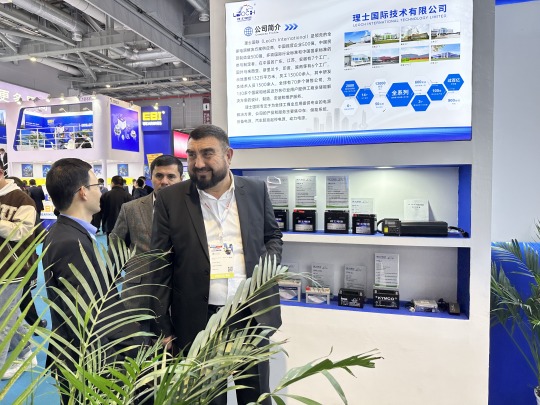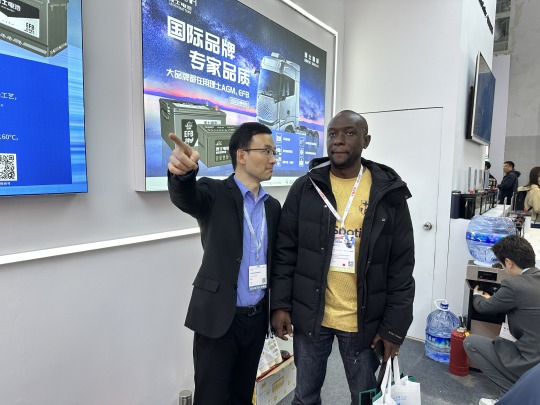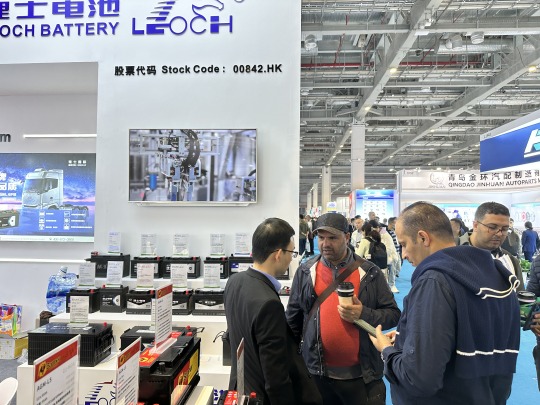#batterytechnology
Explore tagged Tumblr posts
Text




Leoch is the OE supplier for many international automobile manufacturing companies with years of automotive battery experience.
We are confident to be your reliable automotive battery partner! 🤝
Automechanika Shanghai 2023, Leoch is right here! 🚗🔋
#Automobile#CarBattery#Automechanika#EV#StartingBattery#MotiveBattery#AutomechanikaShanghai2023#LeochAutomotiveBatteries#OESupplier#AutomotiveBatteryExperience#ReliablePartner#AutomotiveIndustry#BatteryTechnology#AutomotivePower#BatterySupplier#AutomotiveExcellence
4 notes
·
View notes
Text
#batterytechnologies#EVSafety#BatteryTechnology#FireProtection#CellChemistry#ElectricVehicles#ThermalManagement#BatteryInnovation#SustainableMobility#electricvehiclesnews#evtimes#autoevtimes#evbusines
0 notes
Link
#automotiveindustry#batterytechnology#BYD#electricvehicles#EU-ChinaTrade#marketexpansion#NIO#tariffs
0 notes
Text

Nissan develops battery that charges in 5 minutes http://dlvr.it/TJyz9w
0 notes
Text
#SemiQ#MOSFET#EVbattery#modules#durability#battery#EV#BatteryTechnology#Innovation#powerelectronics#powermanagement#powersemiconductor
0 notes
Text
The Future of Low-Speed Vehicles: Market Insights & Innovations
The low-speed vehicle market is projected to grow from USD 11.09 billion in 2024 to USD 16.28 billion by 2030 at a CAGR of 6.6% during the forecast period. The low-speed vehicle (LSV) market is expanding due to factors like increased golf participation, growing charging infrastructure, and a rising need for safe, comfortable mobility, especially among seniors. Growth is further fueled by travel…
#BatteryTechnology#CommercialVehicles#ElectricLSV#ElectricTransport#EVRevolution#FutureOfMobility#GolfCarts#GreenMobility#LowSpeedVehicles#LSVIndustry#LSVMarket#SmartTransportation#SustainableMobility#UrbanTransport#UtilityVehicles
0 notes
Text
Hey everyone,
If you're involved in operations that depend on constant, reliable power (like data centers or critical infrastructure), understanding UPS systems is a game-changer. I came across this comprehensive Uninterruptible Power Supply (UPS) course that dives deep into UPS technologies and practices. Whether you're looking to improve your system's reliability or troubleshoot issues, this course offers something for all levels.
What You'll Learn:
Types of UPS Systems: Learn the differences between single-input and double-input UPS systems, and how to select the best one for your needs.
Battery Technologies: Gain insights into lead-acid and nickel-cadmium batteries, along with automated monitoring systems.
Advanced UPS Systems: Understand Diesel Rotary Uninterruptible Power Systems (DRUPS), their advantages, and when to use them.
Installation & Maintenance: Learn best practices for UPS system installation, maintenance, and troubleshooting.
Power Quality: How UPS can address power quality issues and ensure reliability during utility failures.
This course is ideal for anyone responsible for power systems, IT infrastructure, or mission-critical facilities. Have any of you worked with UPS systems before or dealt with power outages in critical operations? I’d love to hear your experiences!
Check out more details here: Uninterruptible Power Supply (UPS)
#UPSTechnology #PowerSystems #CriticalInfrastructure #ITInfrastructure #BackupPower #UninterruptiblePowerSupply #MissionCritical #DataCenter #PowerReliability #UPSInstallation #PowerQuality #BatteryTechnology #Maintenance #PowerSolutions #ITProfessionals #EnergyManagement #FacilitiesManagement #UPSSystems
#UPSTechnology#PowerSystems#CriticalInfrastructure#ITInfrastructure#BackupPower#UninterruptiblePowerSupply#MissionCritical#DataCenter#PowerReliability#UPSInstallation#PowerQuality#BatteryTechnology#Maintenance#PowerSolutions#ITProfessionals#EnergyManagement#FacilitiesManagement#UPSSystems
0 notes
Text
Battery Energy Storage System Market Forecast 2025-2032: Size, Share, and Emerging Opportunities

The global Battery Energy Storage System (BESS) market is undergoing a remarkable transformation, driven by the increasing demand for renewable energy integration, grid stability, and the need for cleaner energy solutions. As the world shifts towards sustainability, the adoption of BESS technologies has gained momentum due to their ability to store excess energy for later use, helping to stabilize power grids and optimize energy consumption. The global BESS market is poised for significant growth in the coming years, with analysts predicting a robust expansion by 2032.
Battery Energy Storage Systems (BESS) are crucial components in modernizing the electrical grid, facilitating the integration of renewable energy sources, and supporting energy security. These systems allow electricity generated from renewable sources like wind and solar to be stored during periods of low demand and dispatched when demand is high. They provide a valuable solution for overcoming the intermittent nature of renewable energy and improving grid resilience. With advancements in battery technologies and decreasing costs, the market for BESS is poised for a substantial increase in the next decade. The demand is largely driven by global trends in decarbonization, energy storage innovations, and an increasing need for backup power systems.
To Learn More About This Report, Request a Free Sample Copy - https://www.skyquestt.com/sample-request/battery-energy-storage-system-market
Battery Energy Storage System Market size was valued at USD 5.63 Billion in 2024 to USD 40.3 Billion by 2032, growing at a CAGR of 27.9% during the forecast period (2025-2032).
Market Drivers
Several factors are contributing to the growth of the Battery Energy Storage System market:
1. Renewable Energy Integration: As governments worldwide work toward reducing carbon emissions and expanding renewable energy sources, BESS plays a crucial role in enabling a smooth transition. Solar and wind power are variable by nature, and energy storage systems help bridge the gap by storing excess energy for later use.
2. Declining Battery Costs: Over the last decade, the cost of lithium-ion batteries and other energy storage technologies has significantly decreased, making BESS more affordable. Technological innovations and economies of scale in battery manufacturing are expected to continue driving price reductions.
3. Grid Modernization and Stability: With the increasing complexity of electricity grids, BESS helps in grid stabilization by offering frequency regulation, voltage control, and backup power. This is particularly important as grids become more decentralized with distributed generation.
4. Energy Security and Backup Power: BESS is also gaining traction for residential and commercial applications due to its ability to provide reliable backup power during outages. This is especially important in areas prone to natural disasters or where the power supply is unreliable.
5. Government Support and Incentives: Governments across the globe are providing policies, subsidies, and incentives to support the development and deployment of energy storage systems. This has boosted the market's growth, particularly in regions like North America, Europe, and Asia-Pacific.
Market Trends and Innovations
The BESS market is characterized by several key trends and innovations:
1. Growth of Utility-Scale Energy Storage: Large-scale storage systems that provide grid services are growing rapidly. These systems are critical for ensuring grid reliability and can store large amounts of energy generated from renewable sources.
2. Solid-State Batteries: While lithium-ion batteries dominate the market, researchers are increasingly exploring solid-state batteries due to their higher energy densities, longer life cycles, and improved safety profiles. Solid-state technologies could significantly impact the BESS market in the coming years.
3. Second-Life Battery Storage: The use of second-life EV batteries for stationary energy storage applications is gaining attention. These batteries, after they are no longer suitable for electric vehicle use, can still offer substantial energy storage capacity for grid support, making them an environmentally friendly and cost-effective solution.
4. AI and Smart Technologies: The integration of Artificial Intelligence (AI) and smart grid technologies with energy storage systems is enabling enhanced efficiency in energy management. AI-based algorithms are being used for predictive analytics, real-time monitoring, and optimized charge-discharge cycles.
Make an Inquiry to Address your Specific Business Needs - https://www.skyquestt.com/speak-with-analyst/battery-energy-storage-system-market
Market Segmentation
The Battery Energy Storage System market is broadly segmented based on type, application, and region:
1. By Type:
�� - Lithium-Ion Batteries: The dominant technology due to their high energy density, long cycle life, and falling costs.
- Lead-Acid Batteries: Traditionally used for smaller-scale applications, lead-acid batteries are being gradually replaced by more advanced technologies.
- Flow Batteries: Gaining popularity for large-scale storage applications due to their scalability and longer discharge duration.
- Sodium-Ion Batteries: An emerging alternative, particularly in regions where lithium-ion supply is limited.
2. By Application:
- Utility-Scale: Large installations used by utilities for grid balancing and storage of renewable energy.
- Residential: Small-scale storage solutions for homes to store excess solar power or provide backup power during outages.
- Commercial & Industrial: Businesses use BESS for cost savings, demand charge reduction, and energy management.
3. By Region:
- North America: Strong growth driven by the adoption of renewable energy policies and increasing deployment of storage systems across the U.S.
- Europe: Supported by the European Union's energy transition goals and stringent regulations targeting carbon emissions.
- Asia-Pacific: The largest regional market, with China leading in terms of both manufacturing and deployment of energy storage solutions.
- Middle East & Africa: Increasing investment in renewable energy projects and improving energy infrastructure.
- Latin America: Emerging market for energy storage, with ongoing efforts to integrate renewable energy into the grid.
Battery Energy Storage System Market Top Player’s Company Profiles
Tesla Inc.
LG Chem Ltd.
BYD Company Ltd.
Samsung SDI Co., Ltd.
ABB Ltd.
General Electric Company
Hitachi Ltd.
Siemens AG
Johnson Controls International plc
Saft Groupe S.A.
Panasonic Corporation
Toshiba Corporation
Fluence Energy LLC
Enel X S.r.l.
EnerSys
Contemporary Amperex Technology Co. Ltd.
RES Group
Greensmith Energy (Wartsila Company)
NEC Corporation
VRB Energy Inc.
Take Action Now: Secure Your Battery Energy Storage System Market Today - https://www.skyquestt.com/buy-now/battery-energy-storage-system-market
Market Challenges
Despite the significant growth prospects, the BESS market faces certain challenges:
1. High Initial Investment: Although the cost of batteries is falling, the initial investment for installing BESS systems remains relatively high, especially for large-scale applications. This could hinder adoption, especially in developing countries.
2. Battery Recycling and Sustainability: The environmental impact of battery manufacturing and disposal is an ongoing concern. Developing efficient and sustainable recycling methods will be critical to mitigating the ecological impact.
3. Technological and Infrastructure Constraints: While advancements in energy storage technologies are promising, scalability and integration with existing grid infrastructure pose challenges. Ensuring interoperability and establishing universal standards is crucial for long-term success.
Future Outlook
The global BESS market is expected to grow at a compound annual growth rate (CAGR) of over 27.9% from 2025 to 2032. By 2032, the market size could reach a staggering $40.3 billion, with utility-scale applications continuing to dominate the sector. As renewable energy adoption accelerates, the need for efficient and cost-effective energy storage solutions will become even more critical, propelling further innovation and investment in the industry.
Read Battery Energy Storage System Market Report Today - https://www.skyquestt.com/report/battery-energy-storage-system-market
The Battery Energy Storage System market is on a rapid growth trajectory, driven by technological advancements, supportive policies, and an increasing demand for clean, reliable, and resilient energy solutions. With continued investment and research, BESS has the potential to revolutionize how energy is stored, distributed, and consumed, helping to create a more sustainable energy future.
#BatteryEnergyStorage#EnergyStorage#BESS#RenewableEnergy#CleanEnergy#EnergyStorageSystems#SmartGrid#SustainableEnergy#EnergyTransition#EnergyStorageMarket#BatteryTechnology#EnergyInnovation#GreenEnergy#ElectricVehicles#GridStability#BatteryStorageSolutions#FutureOfEnergy#EnergyEfficiency
0 notes
Text

A cell grading machine ensures accurate and efficient battery cell sorting for superior performance and reliability. Designed for precision, it enhances quality control in battery manufacturing and energy storage applications.
#CellGradingMachine#BatterySorting#PrecisionEquipment#BatteryManufacturing#EnergyStorage#BatteryTechnology#QualityControl#IndustrialAutomation#BatteryProduction
0 notes
Text
Future of Battery Technology: Market Growth, Innovations, Shift Towards Eco-Friendly Alternatives
The global battery market size is anticipated to reach USD 329.84 billion by 2030 and is projected to grow at a CAGR of 16.4% from 2025 to 2030, according to a new report by Grand View Research, Inc. This robust growth is driven primarily by the increasing adoption of electric vehicles (EVs) and the expanding demand for renewable energy storage solutions. As governments worldwide push for greener technologies and lower carbon emissions, the demand for batteries-especially lithium-ion batteries-has surged, given their efficiency, longevity, and versatility across multiple applications.

A significant trend shaping the global market is the shift towards sustainable energy solutions. The growing emphasis on renewable energy sources, such as solar and wind, necessitates reliable energy storage systems to manage the intermittent nature of these power sources. Batteries play a critical role in stabilizing the grid and ensuring consistent energy supply, thereby driving their demand across residential, commercial, and industrial sectors. In addition, advancements in battery technology, such as improvements in energy density and faster charging capabilities, are making batteries more attractive for large-scale energy storage applications.
Battery Market Report Highlights
The lithium ion segment led the market with the largest revenue share of 44.0% in 2024, owing to their high energy density, long cycle life, and widespread use in electric vehicles, consumer electronics, and renewable energy storage. Their declining costs and technological advancements have further accelerated their adoption across various applications, solidifying their market dominance
Based on end use, the automobile segment led the market with the largest revenue share of 31.0% in 2024, owing to the rapid growth of electric vehicles (EVs) and hybrid vehicles, which require advanced batteries for performance and range. Government incentives and environmental regulations are further boosting the demand for automotive batteries, driving their significant market share
Asia Pacific battery market dominated globally in 2024 in terms of the largest revenue share of over 54.0%.
In March 2024, 24M Technologies, a Massachusetts-based battery technology company, introduced 'Liforever', a direct material recycling technique for semi-solid lithium-ion batteries for electric vehicles and energy storage systems. This technology helps reduce the environmental impact of lithium-ion batteries by allowing efficient and cost-effective recovery and reuse of battery ingredients such as lithium iron phosphate (LFP), both during the manufacturing process and at the end of life
For More Details or Sample Copy please visit link @: Battery Market Report
The rise of the electric vehicle market is another key factor propelling battery demand. With countries like China, the United States, and those in Europe setting ambitious targets for EV adoption and phasing out internal combustion engines, the need for efficient, high-capacity batteries has become more pressing. Automakers are increasingly investing in battery technology to enhance vehicle range, reduce charging times, and lower overall costs. This trend is expected to drive substantial growth in the automotive battery segment, particularly for lithium-ion batteries, which remain the preferred choice for EV manufacturers.
Technological innovation is also a major trend in the global market. Companies are investing heavily in research and development to create next-generation batteries, such as solid-state batteries and lithium-sulfur batteries, which promise higher energy densities, greater safety, and longer lifespans. These advancements are anticipated to open new opportunities across various sectors, from consumer electronics to aerospace and defense, further expanding the market's potential. In addition, the declining cost of batteries due to economies of scale and improved manufacturing processes is making them more accessible, accelerating their adoption in both developed and developing regions.
The market is witnessing increased focus on sustainability and recycling. As battery demand grows, so does the concern over sourcing raw materials like lithium, cobalt, and nickel, which are essential for battery production but often involve environmentally and ethically questionable practices. In response, there is a growing emphasis on developing sustainable supply chains, improving recycling processes, and exploring alternative materials to reduce the environmental footprint of battery production. These efforts are expected to foster long-term growth and resilience in the global market, ensuring its alignment with global sustainability goals.
List of Key Players of Battery Market
A123 Systems, LLC
BSLBATT USA
BYD Co. Ltd
Clarios, LLC
CROWN BATTERY
Discover Battery
Duracell Inc.
East Penn Manufacturing Co.
EnerSys, Inc.
EXIDE INDUSTRIES LTD.
We have segmented the global battery market report based on material, end use, application, type, and region
#BatteryMarket#BatteryIndustry#EnergyStorage#BatteryTechnology#PowerSolutions#EnergySector#LithiumIonBattery#SolidStateBattery#EVBatteries#RechargeableBatteries#AdvancedBatteries#GreenEnergy#BatteryRecycling#CleanEnergy#NextGenBatteries#TechInnovation
0 notes
Text
Starting batteries are not only necessary to start the engine, but also to power the electrical components during driving. 🔋
Discover the benefits of Leoch starting batteries: ① Excellent resistance to high and low temperatures ② Withstand frequent starting ③ Resistant to shock and vibration ④ Safe and environmentally friendly
Watch the video and then start your car with Leoch Battery!💨
Starting your journey with Leoch's powerful starting batteries. 🚗
#StartingBattery#HighEfficiency#ExcellentPerformance#EV#BatteryTechnology#LeochStartingBatteries#PowerfulStart#EngineStarting#ElectricalPower#HighLowTemperatureResistance#FrequentStarting#ShockVibrationResistance#SafeEnvironmentallyFriendly#CarBattery#LeochBattery
3 notes
·
View notes
Text
#aerospace#LithiumSulfur#BatteryTechnology#EnergyStorage#EVInnovation#SustainableEnergy#CleanTech#NextGenBatteries#electricvehiclesnews#evtimes#autoevtimes#evbusines
0 notes
Link
#automotiveinnovation#batterytechnology#BMW#electricvehicles#EVrange#FutureMobility#greenenergy#siliconcarbide
0 notes
Text
Electric Vehicles 2024


Electric Vehicles 2024: Latest Models and Technological Advances
Electric Vehicles 2024, the electric vehicle (EV) industry has moved far forward. The 2024 electric vehicle landscape has become changed, leaving us enthralled about transport. EVs are becoming the go-to mode of transport for consumers as worries over climate change, progressively higher prices of fuels, and rapid technological advancements have had time to register the respective contributing components. Right from new models and battery technology advancements to the growth of electric vehicle charging networks, the electric vehicle overall landscape is changing incredibly rapidly. This article delves into what's coming up as regards the key events and trends regarding the electric vehicle undercurrent in 2024. 1. Best-Ever EV Sales 2024 will be a major year for electronic vehicles, as global sales are expected to soar to heights never reached before. The EV sales rate will go up to around 20% of the world's total sales across all vehicles from a mere 10% in 2020. Some of these additional factors fueling the growth are increased environmental awareness, government resources in incentive disbursement, and a wider choice of affordable electric models in the market. Automakers ranging from traditional giants to new entrants have started working more intensively on EVs. Tesla, Volkswagen, GM, and Ford are leading the charge, and even more than that, Chinese manufacturers such as BYD and NIO emerge quickly as market catchers in the battle going on internationally. Consumers have a stronger edge in this day and age because the competition is more: more competition makes the contests more intense, thereby expanding the variety in the end for the customer in terms of price, design, and features. 2. Innovation in Battery Technology Advanced battery technology will also play a major role. This is in keeping with the expectation of high achievement in this year 2024. Power-wise, it has remarkable batteries that beat the cost down and increase mileage as far as lifespan is concerned. Nowadays, solid-state batteries offer potentially greater energy density and faster charging times, commencing the entry into commercialization. The storage battery uses a solid electrolyte rather than a liquid electrolyte presented in traditional lithium-ion batteries. Having potential safety benefits, including lightness and low energy, solid-state batteries are still at the development stage and are expected to usher in a revolution in the EV industry in the years to come. There is a new aspect of improvement of LFP (lithium iron phosphate) battery technology because low cost, wider lifespan, and better safety make it highly popular with manufacturers. Manufacturers continue to apply LFP technology as a solution to making affordable electric vehicles without shortchanging the performance. Improved Charging Infrastructure One of the biggest hurdles to widespread EV adoption has been the lack of charging stations. However, in 2024, the charging infrastructure is growing rapidly, addressing one of the primary concerns for potential EV buyers. Governments worldwide are making significant investments in charging networks, and private companies are also increasing their efforts. Alongside the increase in charging stations, there is a heightened emphasis on fast-charging technology. Ultra-fast chargers that can add 200 miles of range in under 20 minutes are becoming more prevalent, making long-distance travel more practical for EV owners. Additionally, wireless and inductive charging systems are being investigated, which could offer even greater convenience for EV drivers in the future. Sustainability and Recycling Initiatives Sustainability is central to the electric vehicle revolution, and in 2024, there is a stronger focus on making the entire lifecycle of an EV more environmentally friendly. Automakers are striving to lower the carbon footprint associated with vehicle production, incorporating recycled materials into car manufacturing, and enhancing the energy efficiency of EVs. Another important aspect is the recycling of EV batteries. As more electric vehicles reach the end of their useful life, effective recycling will be essential for minimizing waste and recovering valuable materials such as lithium, cobalt, and nickel. Numerous companies are advancing efficient battery recycling methods, and the European Union has implemented new regulations to ensure that battery recycling becomes a standard practice in the industry. 5. Government Policies and Incentives Government policies are crucial in promoting the adoption of electric vehicles, and in 2024, many countries are providing financial incentives to make EVs more appealing to consumers. Tax credits, rebates, and lower registration fees remain popular forms of support for those purchasing electric vehicles. Moreover, stricter emissions regulations are compelling automakers to transition to electric drivetrains. Various cities and regions are implementing low-emission zones, allowing only EVs and other clean vehicles, which further encourages the shift towards electric mobility. In the U.S., the Biden administration’s commitment to electric vehicle adoption is clear through its proposed infrastructure investments aimed at establishing a nationwide network of EV charging stations. Meanwhile, China’s robust policies, including subsidies and incentives for EV buyers, are helping it retain its status as the largest EV market globally. 6. The Rise of EV Fleets and Shared Mobility Another trend gaining traction in 2024 is the increasing use of electric vehicles by fleets. Delivery companies, ride-hailing services, and car rental agencies are progressively transitioning to electric vehicles. Companies such as Amazon, UPS, and FedEx are making significant investments in EVs to lower their carbon footprints and reduce operational costs. In addition to fleet adoption, shared mobility services are also integrating more EVs into their offerings. Companies like Lyft, Uber, and various car-sharing services are providing electric options to customers in major urban areas, facilitating access to clean transportation without the need for vehicle ownership. 7. Electric Trucks and SUVs The electric vehicle revolution isn't just about compact sedans and hatchbacks anymore. In 2024, electric trucks and SUVs are gaining traction, with automakers rolling out a variety of options to meet the rising demand for these vehicles. Brands like Rivian, Ford, and Tesla have already launched electric pickups, while others such as Chevrolet and GMC are set to introduce their electric trucks shortly. Electric trucks come with numerous benefits, including reduced operating costs, quieter rides, and zero emissions. For businesses that depend on transportation, electric trucks can lead to substantial savings over time while also supporting sustainability initiatives. As electric trucks and SUVs continue to gain popularity, we can expect even more options in this segment in the coming years.
Conclusion
The Electric Vehicles 2024 market in is a vibrant and rapidly changing landscape, characterized by technological advancements, enhanced infrastructure, and growing acceptance among consumers and businesses alike. With improvements in battery technology, more convenient charging solutions, and ongoing government incentives, the future of electric mobility appears more promising than ever. Electric Vehicles 2024 is poised to be a crucial moment in the EV revolution, as electric vehicles become a fundamental part of the global automotive scene. Whether driven by environmental concerns, cost efficiency, or performance advantages, an increasing number of drivers are opting for electricity as their transportation choice. Looking ahead, the shift to electric vehicles is set to transform how we travel, contributing to a cleaner, greener, and more sustainable world. Read the full article
#BatteryTechnology#ElectricTrucks#Environmentallyfriendly#Incentives#Infrastructure#RecyclingInitiatives#SharedMobility#Technology#Volkswagen
0 notes
Text
The Future of Lithium-Ion Batteries: Innovations Ahead
Lithium-ion batteries have revolutionized the way we power our devices, from smartphones to electric vehicles. But what does the future hold for this incredible technology?

Exciting innovations are on the horizon! Researchers are exploring solid-state lithium-ion batteries, which promise greater safety and higher energy density. Additionally, advancements in fast-charging capabilities could reduce charging times significantly, making EVs even more practical.
Another breakthrough is the development of lithium-sulfur batteries, which could store up to five times more energy than traditional lithium-ion cells. These innovations could reshape industries, creating a more sustainable and efficient energy future.
Speaking of batteries, if you're looking for smaller cells, like a reliable SR626SW battery, don't forget to explore options that meet your needs. Keep an eye on these tech advancements—they’re set to power tomorrow!
What do you think about the future of lithium-ion technology? Let’s chat! 🚀🔋
#LithiumIonBatteries#BatteryInnovation#FutureOfEnergy#EnergyStorage#BatteryTechnology#SustainableEnergy#GreenTechnology#ElectricVehicles#CleanEnergy#TechInnovation#BatteryResearch#LithiumBatteries#BatteryRevolution#SmartEnergy#PoweringTheFuture
0 notes
Text
🔋 Lithium-ion Battery Material Market: Powering a Greener Future! 🔋
#LithiumIonBatteries#BatteryTechnology#EVBatteries#EnergyStorage#SustainablePower#RenewableEnergy#NextGenEnergy#BatteryMaterials#CleanEnergyFuture
0 notes